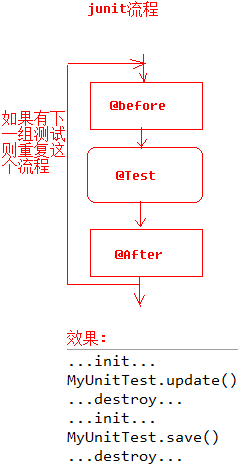
模拟junit4.x,先得明白junit4.x的运行效果:
先执行@Before标注的方法,再运行@Test标注的方法,最后运行@After标注的方法.
思路:
1:开发出3个注解
2:把注解贴在测试类中
3:开发第三方程序赋予注解功能(执行的先后顺序)
3.1:获取到要测试的字节码对象
3.2:获取字节码对象中的所有方法
3.3:归类区分带有不同注解的方法,分3类
3.4:迭代所有要执行的方法
3.4.1在所有要执行的方法前先执行MyBefore注解的方法
3.4.2在所有要执行的方法后再执行MyAfter注解的方法
自定义After注解
package com.xulihao.zhujie._test;
import java.lang.annotation.ElementType;
import java.lang.annotation.Retention;
import java.lang.annotation.RetentionPolicy;
import java.lang.annotation.Target;
@Retention(RetentionPolicy.RUNTIME)//元注解设置注解执行到哪一步 source class runtime
@Target(ElementType.METHOD)//设置执行的范围
public @interface After {
}
自定义Before注解
package com.xulihao.zhujie._test;
import java.lang.annotation.ElementType;
import java.lang.annotation.Retention;
import java.lang.annotation.RetentionPolicy;
import java.lang.annotation.Target;
@Retention(RetentionPolicy.RUNTIME)
@Target(ElementType.METHOD)
public @interface Before {
}
自定义Test注解
package com.xulihao.zhujie._test;
import java.lang.annotation.ElementType;
import java.lang.annotation.Retention;
import java.lang.annotation.RetentionPolicy;
import java.lang.annotation.Target;
@Retention(RetentionPolicy.RUNTIME)
@Target(ElementType.METHOD)
public @interface Test {
}
测试类Myunitetest
public class Myunitetest {
@Before
public void init() {
System.out.println("init。。。。。。。。");
}
@After
public void end() {
System.out.println("end.........");
}
@Test
public void test1() {
System.out.println("方法一运行中");
}
@Test
public void test2() {
System.out.println("方法二运行中");
}
}
开发第三方程序App类赋予注解功能(执行的先后顺序)
package com.xulihao.zhujie._test;
import java.lang.reflect.InvocationTargetException;
import java.lang.reflect.Method;
import java.util.ArrayList;
import java.util.List;
public class App {
/*
*
模拟junit4.x,先得明白junit4.x的运行效果:
先执行@Before标注的方法,再运行@Test标注的方法,最后运行@After标注的方法.
----------------------
思路:
1:开发出3个注解
2:把注解贴在测试类中
3:开发第三方程序赋予注解功能(执行的先后顺序)
3.1:获取到要测试的字节码对象
3.2:获取字节码对象中的所有方法
3.3:归类区分带有不同注解的方法,分3类
3.4:迭代所有要执行的方法
在所有要执行的方法前先执行MyBefore注解的方法
在所有要执行的方法后再执行MyAfter注解的方法
*/
public static void main(String[] args) throws ClassNotFoundException, IllegalAccessException, IllegalArgumentException, InvocationTargetException, InstantiationException {
Method befo=null;
Method aft=null;
List<Method> methodlist=new ArrayList<>();
//获取测试的字节码对象
Class<?> clz=Myunitetest.class;
//Class<?> clz=Class.forname();
Object obj=clz.newInstance();//反射创建对象
Method[] meth=clz.getMethods();//得到类的方法对象并存到method数组中
for (Method me : meth) {//归类区分
if(me.isAnnotationPresent(Before.class)) {//根据注解判断方法
befo=me;
}else if(me.isAnnotationPresent(After.class)) {
aft=me;
}else if(me.isAnnotationPresent(Test.class)){
methodlist.add(me);
}
}
for (Method m : methodlist) {//迭代要执行的方法
if(befo!=null) {//在执行之前,首先得判断这个方法是否存在
befo.invoke(obj);//invoke后要传当当前类的对象
}
m.invoke(obj);//通过反射调用方法
if(aft!=null) {
aft.invoke(obj);
}
}
/*
System.out.println(befo);
System.out.println(aft);
System.out.println(methodlist);
*/
}
}
执行效果
